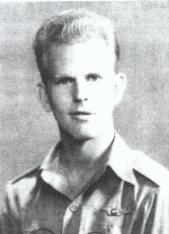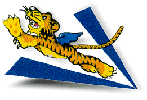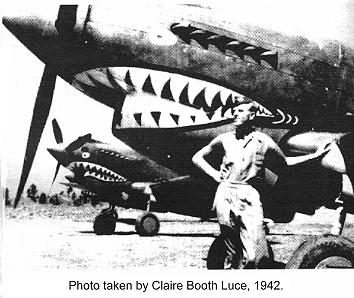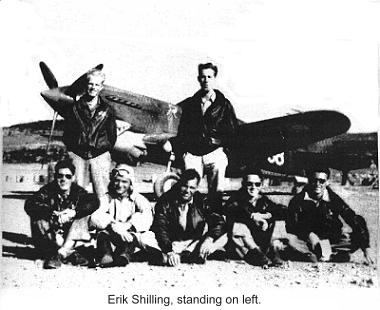
Shop Amazon - Create an Amazon Baby Registry



The P-40B (Tomahawk IIA) flown by the Flying Tigers had. . .
Self sealing fuel tanks. . . Japanese aircraft had none. Armor plate that would stop any bullets fired from a Japanese fighter or bomber encountered over Burma. Bullet proof windshield that would stop any Japanese fighter or bomber's machine gun bullets. Very much stronger than the flimsily constructed Japanese aircraft. A number of Zeros shed their wings at speeds slightly over 350 IAS mph. Japanese would not even attempt a dive that approached 350 IAS. None of Japan's aircraft could even stand up to P-40's .30 and .50 caliber guns. It only required a few incendiary bullets, even from our .30 cal. guns, to set fire to, or explode their aircraft.

Now why in the hell would anyone consider the Zero to be the best fighter of the war?
Hell, it didn't even start out that way. . .
The above is not just my opinion, but garnered from available
facts, and flying the P-40 in combat.
What was truly obsolete happened to be the turning or dogfighting combat that had been used during of WW I.
Although avoidable, possibly the tumble the P-40 would get into if stalling in an extreme nose high attitude. It would start a tail slide, finally swapping end for end and go into a tumble taking as much as 12,000 feet to recover. Frank Shield got into a tumble while we were having a dog fight. Frank had to bail out. He had not recovered control while only a scant 2000 feet still in a vertical dive. He entered the tumble at 10,000 feet. I believe another couple thousand feet would have given him sufficient altitude to recover. Once understood, the tumble was easily avoided.
Japanese pilots were highly disciplined. I observed them holding a close formation even when their leader was burning fiercely and could have exploded any moment. Damn few were up to the standards of our pilots graduated from the American military school in the states, especially prior to Pearl Harbor. However, most Americans were using the wrong tactic through no fault of their own. Combat in all theaters turned in our favor, improving considerably once this was overcome.
Of all the fighter planes flown against the Japanese, the P-40 was the most under-rated airplane and the Japanese Zero was the most overrated. Contrary to popular belief, the P-40's larger turning radius did not present a problem when understood, and proper tactics were used against the Japanese fighters. Also its lower rate of climb could easily be overcome. The P-40 which was more than 40 mph faster than the zero, could still climb at a speed that the zero was incapable of attaining. Pilots that tried to dogfight lost their lives. Whereas the hit and run tactic with a faster plane was the only way to fight the Hayabusa or Zero.
Erich Hartman, Germany's leading Ace with 352 victories said, "I always avoid the turning combat when ever possible. "In half of my victories," Hartman said, "the pilot was unaware he was under attack until he was being hit." He was also an extremely good marksman. Erich Hartman averaged 70 victories a year. Therefore, why is it so difficult for some Americans to believe that 82 AVG pilots destroyed 297 Japanese in a seven month period?
To put our victories in their proper prospective: If all the AVG pilots had been of Eric Hartman's caliber, we would have destroyed 3,052 airplanes in this 7 month period. Provided there had been enough Japanese airplanes available to shoot down. Now, 296 doesn't seem so terribly outstanding, as a matter of fact somewhat shabby.
The AVG encountered 4 types of Japanese aircraft in their fight over Burma and southeast China. Two were fighters, the Hayabusa we called the I-97 and the Mitsubishi*, an obsolete fixed geared fighter, the I-96. The only Japanese bomber was the I-97, which I think was called the Sally, and an occasional Japanese photo-recon plane.
The P-40s was 50 mph faster than the Hayabusa we called the I-97.
The P-40's top speed was 70 mph faster than the I-96, an early fixed geared Mitsubishi*.
The P-40 was 130 mph faster than the Japanese bomber, and 130 mph faster in a dive than any fighter the Japanese had.
The P-40's pilot protection was in the form of self-sealing fuel
tanks. Almost two - inch thick bullet proof armor plate
windshields, and 9 mm and 7 mm armor plate protecting the pilot
from behind. Also the P-40's armor plate could stop the bullets
from any military aircraft the Japanese had in the China - Burma theater.
The most irritating:
One author, writing for the Smithsonian's Air & Space magazine claims, "The Zero to be the most fabulous fighter to come out of the war." Those making such statements are ill informed. They either never flew the Zero, never fought the Zero as it should have been, and most likely are not pilots, nor aeronautical engineers, so how the hell do they know.
Aviation buffs always come up with the statement that the Zero was more maneuverable than the P-40. Emphatically not true. Flown properly the P-40 was an outstanding fighter, especially in the Chinese theater of war.
Actually the P-40 was more maneuverable than the Zero. Unfortunately, those that claim otherwise do not know the definition of maneuverability as defined by Webster's dictionary.
1. To perform a movement in military or naval tactics in order
to secure an advantage.
2. An intended and controlled variation from a straight and
level
flight path in the operation of an aircraft.
3. To make a series of changes in direction and position for
a specific purpose.
4. Evasive movement or shift of tactics.
5. To manage into or out of a position or condition.
6. To bring about or secure as a result of skillful
management.
In a short but informative interview with Saburo Sakai, Japans leading living Ace, I asked, "Commander, what was the Zero's top speed?" His answer amazed me when he said, "The A6M2 had a top speed of 309 mph. and a maximum allowable dive speed of 350 mph. It became extremely heavy on the controls above 275 mph, and approaching 350 mph, the Zero's controls were so heavy it was impossible to roll. A further comment by Sakai was that the skin on the wings started to wrinkle, causing the pilot great concern, since a number of Zero's had shed their wings in a dive." A captured Zero tested by Americans military, showed its top speed to be 319 mph, this was a later model, the AM6M5, and was tested without guns or ammunition. Therefore Saburo Sakai's statement that the top speed of the A6M2 and A6M3 of 309 mph would seem to be correct.
Saburo Sakai, in an interview made on August 11, 1996, admitted that, after flying the P-51 he had changed his mind and now rated the Zero as number two, where as before he thought it was the best. He said, "the P-51 could do everything the Zero could do and more." My comment to him would have been that it's too bad you never got the opportunity to fly the P-40.
Compare this to the P-40's 355 mph, and he the maximum allowable dive speed of 480 mph, (occasionally our pilots dove as fast as 510 mph) 130 mph faster than the Zero. The P-40's roll rate at 260 mph was 96 degrees per second, three times that of the Zero's mere 35 degrees at the same speed.
Japanese pilots were taught the antiquated importance of Dogfighting, or turning combat as used in WW I. Unfortunately our military pilots were taught the same thing, dogfighting. But the Americans didn't have the equipment with which to be successful. When the Japanese encountered Chennault's hit and run tactics, they were at loss. It wasn't in their book, and they didn't know how to handle the situation.
"Tokyo Rose" during one of her many English broadcasts, admonishing AVG pilots saying, "Why won't you stay and fight? You're cowards, always running away. Are you afraid of our courageous pilots?" Undoubtedly our hit and run tactics were obviously hurting and the Japanese were too stupid to realize the information she was giving us.
On December 24, 1941, Tokyo Rose announced over the radio that Japan had a Christmas present for the AVG. How utterly stupid, we were ready and waiting. The AVG were confirmed to have shot down 13 fighters and 4 bombers. The British got 6, all confirmed. No losses by AVG or RAF.
The Americans were still using the suicidal "Dogfight," or turning combat. When the Lockheed P-38s were first introduced into the Pacific theater in 1943. Saburo Sakai says, "The Zeros were shooting them down in large numbers." Although the Lockheed had a 100 mile per hour speed advantage, this is what happened when the airplane wasn't being used properly. Saburo further states, "When the Americans changed their tactic, the Zero pilots became fearful of the P-38, because they were decimating the Zeros."
As early as September 1941 Chennault was teaching us to hit and run, requiring speed, which was the P-40's forte against the Japanese. When properly used, it outclassed the Japanese Zero in every respect. It took the American Military 2 more years, and the loss of several hundred American pilots, before they stumbled on the secret of successfully fighting the Japanese in the air.
According to revisionists, the weave was first used during the battle of Midway, giving credit to Commander Thatch for inventing it, and referred to it as the "Thach Weave."
An article in the Smithsonian magazine, Air & Space, said that Lt. Commander Thach had developed the weave which he said contributed in a large part, "...To the success of the Battle of Midway...." However, Commander Thatch admits he had heard it was used in China. Incidently this weave was used, during our training at Toungoo, and was part of a combat report when the AVG first encounter the Japanese on December 20, 1941.
A controversy developed about the invention of the Thach "Weave" and later it was discovered that Commander never called it a weave but a "Beam Defence," which incidently was not a "Weave" as every one seemed to think.
In 1992, on our fiftieth anniversary of the deactivation of the Flying Tigers, we finally received the long over due recognition from the military in the form of a Presidential Unit Citation for our group, and a promise of Honorable discharge from the United States Air Force was forth coming. The wording of the Citation acknowledged that we were members of the U. S. military on a covert secret mission. The unit citation specifically named the AVG as Flying Tigers.
Air Force regulations prohibit the use of the name of any unit that had been deactivated. Since the AVG, Flying Tigers were deactivated on July 4, 1942, the name Flying Tigers, by Air Force regulation, prevented any Air Force unit using this name.
These are the reason why we guard our name and record so vehemently. This small group set a record in military aviation that no outfit has ever come close to equaling, and undoubtedly never will.
Chennault was fully aware that it was the Flying Tigers that gave him the opportunity to prove his tactics, and said so in his biography. He knew it was because of the AVG's outstanding combat record that forced the military to reluctantly accept him as a force to be reckoned with, in the makeup of a fighter force in China. Due to world-wide publicity of his Flying Tigers, made it impossible for the military to ignore Chennault and the accomplishments of Flying Tigers which he commanded.
As great a tactician as Chennault was, it was highly unlikely that the Air Force would have even considered returning Chennault to active duty. Even so, with his leadership established, there was a great deal of opposition to Chennault's appointment as a General by many high ranking military. Without the AVG, Chennault would have never been made the Commanding General of the 14th Air Force, much less being recalled to active service. Chennault needed the Flying Tigers to prove his tactics. As a result of his knowledge of the Japanese military that was imparted to the AVG, and using the tactics learned from him they became famous. The 14th's record alone would never have made him world famous. I wonder, beside Chennault and LeMay, both controversial figures, how many other Air Force commanders can the average person name?
Three days after my 80th birthday, I finally received my discharge from the USAAF dated July 4, 1942, and the following awards: The Distinguished Flying Cross with oak leaf cluster, Air Medal with oak leaf cluster, Asiatic Campaign medal with four battle stars, WW II victory medal, and Presidential Unit Citation with oak leaf cluster.

I believe, the lesson that everyone could learn is that a few dedicated men, with proper leadership, can accomplish greatness even in the face of adversity and hostile opposition.
*Editor's Note: The fixed gear fighter that Mr. Shilling refers to was not manufactured by Mitsubishi. It was manufactured by Nakajima and designated as the Ki-27.
